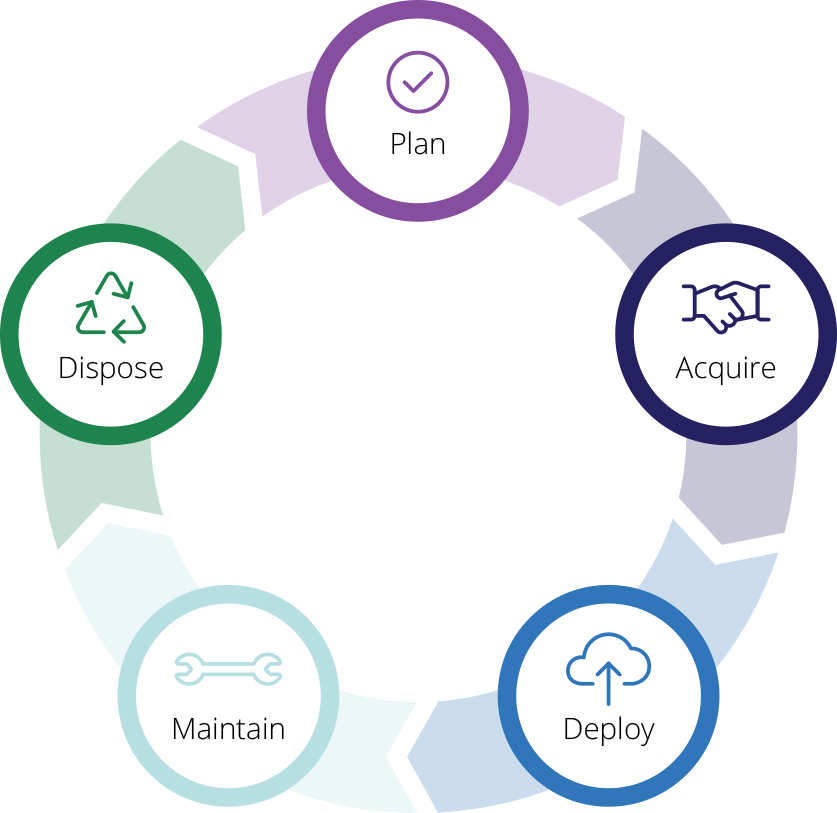What is ITAM?
ITAM, or IT Asset Management, tracks and manages all of a company’s IT assets, including hardware, software, licensing, and contracts. In other words, ITAM is a way to handle all of the moving parts of a company’s IT infrastructure.
IT assets have a limited lifecycle, so it’s essential to track them from the moment they’re purchased until they’re retired. This way, companies can make sure they’re getting the most out of their investment (and not overspending on out-of-date or out-of-support hardware!).
Creating an effective ITAM strategy requires a clear understanding of all the company’s IT assets, and a plan for how to manage them throughout their lifecycle. IT departments must deploy, monitor, and maintain IT assets while determining whether the assets must be optimized, replaced with cheaper options, or upgraded with more modern technology.
Sounds pretty easy right? The truth is, ITAM is far more complicated than ever before. Previously, IT departments were in complete control of all IT assets—they were physically issued to employees by the organization itself. But now, with the proliferation of cloud computing, employees are using a variety of devices to access corporate data and applications, including their own laptops, tablet, and mobile devices.
This has resulted in what’s known as Shadow IT: the use of applications and devices for work purposes not directly under the control of the IT team. While Shadow IT can increase productivity, it also creates security risks. Add to this subscription-based software model and the rise of the Internet of Things (IoT), and it’s becoming pretty difficult to keep track of all the different IT assets in a company.
As a result, ITAM has become an increasingly important part of a company’s overall IT strategy because it helps to ensure that all IT assets are properly managed and accounted for.
Why is IT asset management important?
There’s several key reasons why your IT teams would want to institute a robust ITAM program:
- Aligned goals across the organization. A good ITAM strategy provides IT teams with greater insight into the organization’s IT assets and the related ROI, which can be shared with key stakeholders. As a result, technology and business goals remain aligned across the organization.
- Increased operational efficiency. Reduce the amount of time and money spent on managing IT assets while also freeing up valuable resources that can be used for other tasks.
- Improved security. ITAM can help identify which assets are most at risk and take steps to mitigate those risks.
- Reduced costs. Reduce costs by optimizing the use of existing assets and identifying opportunities for cost savings. For example, ITAM can help identify when an asset needs to be upgraded or replaced and determine whether there are cheaper alternatives available.
- Improved decision-making. With a clear understanding of all IT assets, companies can make informed decisions about which assets need to be upgraded or replaced. This way, companies can avoid making costly mistakes when it comes to their IT infrastructure.
- Improved compliance. In many industries, there are strict regulations about how data must be managed and stored. IT asset management can help companies ensure they are compliant with these regulations.
ITAM is also an essential step in implementing ITIL processes, such as problem, change, and incident management. To properly implement ITIL processes, businesses must clearly understand all their IT assets and how they are being used. ITAM can help to provide the necessary up-to-date information that will enable teams to adapt quickly and even predict the effects of any changes to be implemented. This streamlines operations across the organization, providing a vital competitive edge through faster value delivery.
Understanding the IT asset lifecycle
The IT asset lifecycle includes five main phases:

- Planning. IT teams work with business units to identify the assets needed to support the organization’s goals. This includes considering the type, quantity, and quality of assets needed.
- Acquisition. This includes ordering the assets and ensuring that they are delivered to the correct location.
- Deployment. IT assets are installed and made available for use. This includes configuring the assets and ensuring they are properly tested before going live.
- Maintenance. Throughout the lifecycle of the IT asset, this includes patching, upgrading, monitoring the performance of the assets, and making sure they are meeting the needs of users.
- Disposal. When an IT asset reaches the end of its lifecycle, it needs to be disposed of safely and responsibly. This includes ensuring that all data is erased and the asset is recycled or reused in accordance with any applicable laws and regulations.
By following this process, companies can avoid the waste of resources and the potential risks associated with improperly managed assets.
The most common IT asset management processes
While we’ve already answered the question “what is ITAM,” it’s important to delve a little deeper into some of the most common processes. In an ideal world, a perfect ITAM strategy would involve a centralized system to manage all things IT, from hardware and software to customer and employee information.
ITAM can help organizations achieve something close to this ideal while ensuring they can stay on top of their IT investments by simplifying the management of tech budgets, user information, analytics, and other relevant information. Achieving this goal requires a well-designed ITAM system that can track, monitor, and report on all aspects of an organization’s IT assets.
Do this!
Some of the most common processes involved in ITAM are:
- Asset discovery. The first step in any ITAM process is identifying all of the organization’s assets. This can be a challenge, especially for large organizations with complex IT infrastructure. Ideally, this should be an automated process.
- Monitoring hardware and software metrics. It’s essential to monitor asset metrics, such as the number of IT assets, underused and overused licenses, and maintenance costs. This will allow you to improve asset performance, optimize usage, and reduce repair and maintenance times and costs.
- Tracking the complete lifecycle. IT assets have a limited lifespan. Therefore, it’s essential to track when they were acquired, how long they will last, and when they need to be replaced. This will help you avoid disruptions and ensure that your assets are always up-to-date.
- Tracking loaned-out equipment. If equipment is loaned out, it’s essential to monitor where it is and when it needs to be returned. This will help you avoid losing track of valuable assets while also reducing security risks.
- Tracking asset location. If your organization functions in more than one location, it’s essential to keep track of your IT assets’ locations. This will allow you to maintain better inventory as you’ll know what assets you have available and where thereby making usage more efficient.
- Tracking access to IT assets. To maintain security and compliance, it’s important to follow who has access to which assets. This information can also improve asset utilization by identifying underutilized assets.
- Warranty management. Keeping track of warranties is essential to maintaining your assets. This will help you avoid disruptions and ensure that your assets are always up-to-date.
- License management. One of the most critical aspects of ITAM is managing licenses. This includes tracking license usage, monitoring compliance, and managing renewals.
Essential IT asset management best practices
To get the most out of your IT assets, there are a few best practices you should follow:
- Develop a plan. Start with a plan that outlines your goals and objectives. This will help you determine the best way to optimize your assets and ensure that all stakeholders are on the same page.
- Build an IATM team. It’s crucial to have a dedicated team in place. This team should be responsible for all aspects of ITAM, from asset discovery to licensing management.
- Automate wherever possible. Automating processes can improve efficiency, reduce errors, and free up time to focus on other tasks.
- Integrate ITAM into your broader ITSM strategy. Integrating ITAM into other processes, such as incident management and change management, can further improve efficiency and optimize asset utilization.
- Monitor and review regularly. ITAM is an ongoing process, not a one-time event. You need to monitor and review it regularly. This will allow you to identify problems early and make the necessary changes to keep your assets optimized.
- Ensure compliance. By ensuring that your processes are compliant with relevant regulations, you can avoid disruptions and ensure that your assets are always up-to-date.
- Documentation. By documenting your processes, you can improve efficiency and ensure that all stakeholders are on the same page.
- Manage vendors. Keep track of vendor contracts, renewals, and monitor performance.
- Manage disposals. This includes ensuring that data is wiped and the asset is recycled or disposed of securely.
Discover how Auvik can help your ITAM processes
Auvik’s is designed to help you manage and optimize your IT assets. Auvik can help you automate many of the tasks associated with IT network asset management, such as asset discovery, lifecycle management, inventory, and compliance reporting.
Auvik automates the asset documentation process, helping you create a comprehensive overview of your network in minutes, thanks to automated mapping, inventory, and documentation. This gives you the visibility to make informed decisions about your assets.
And with Auvik, you’ll never have to worry about multiple locations. Our distributed site management feature ensures you can view your entire organization’s inventory, receive and manage alerts from a central dashboard, and much more.
Your Guide to Selling Managed Network Services
Get templates for network assessment reports, presentations, pricing & more—designed just for MSPs.



